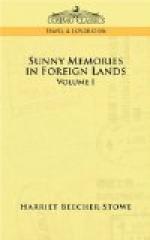There was a painting by Paul de la Roche of the Earl of Strafford led forth to execution, engravings of which we have seen in the print shops in America. It is a strong and striking picture, and has great dramatic effect. But there was a painting in one corner by a Flemish artist, whose name I do not now remember, representing Christ under examination before Caiaphas. It was a candle-light scene, and only two faces were very distinct; the downcast, calm, resolute face of Christ, in which was written a perfect knowledge of his approaching doom, and the eager, perturbed vehemence of the high priest, who was interrogating him. On the frame was engraved the lines,—
“He was wounded for our transgressions,
He was bruised for our iniquities;
The chastisement of our peace was upon
him,
And with his stripes we are healed.”
The presence of this picture here in the midst of this scene was very affecting to me.
The company now began to assemble and throng the gallery, and very soon the vast room was crowded. Among the throng I remember many presentations, but of course must have forgotten many more. Archbishop Whately was there, with Mrs. and Miss Whately; Macaulay, with two of his sisters; Milman, the poet and historian; the Bishop of Oxford, Chevalier Bunsen and lady, and many more.
When all the company were together Lord Shaftesbury read a very short, kind, and considerate address in behalf of the ladies of England, expressive of their cordial welcome. The address will be seen in the Morning Advertiser, which I send you. The company remained a while after this, walking through the rooms and conversing in different groups, and I talked with several. Archbishop Whately, I thought, seemed rather inclined to be jocose: he seems to me like some of our American divines; a man who pays little attention to forms, and does not value them. There is a kind of brusque humor in his address, a downright heartiness, which reminds one of western character. If he had been born in our latitude, in Kentucky or Wisconsin, the natives would have called him Whately, and said he was a real steamboat on an argument. This is not precisely the kind of man we look for in an archbishop. One sees traces of this humor in his Historic Doubts concerning the Existence of Napoleon. I conversed with some who knew him intimately, and they said that he delighted in puns and odd turns of language.
I was also introduced to the Bishop of Oxford, who is a son of Wilberforce. He is a short man, of very youthful appearance, with bland, graceful, courteous manners. He is much admired as a speaker. I heard him spoken of as one of the most popular preachers of the day.
I must not forget to say that many ladies of the society of Friends were here, and one came and put on to my arm a reticule, in which, she said, were carried about the very first antislavery tracts ever distributed in England. At that time the subject of antislavery was as unpopular in England as it can be at this day any where in the world, and I trust that a day will come when the subject will be as popular in South Carolina as it is now in England. People always glory in the right after they have done it.




